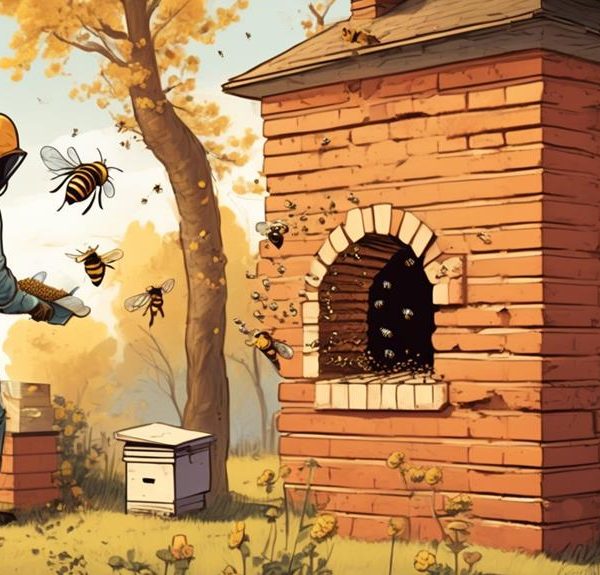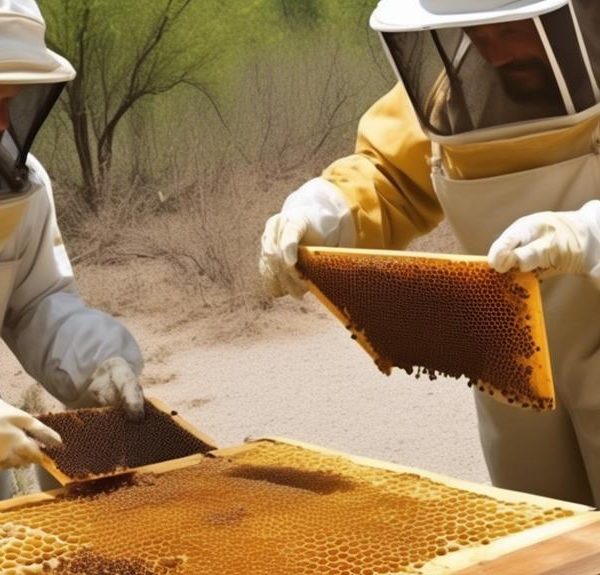Hone in on bee behavior and signs of hive construction with our guide, and discover if your garden has become a buzzing condominium!
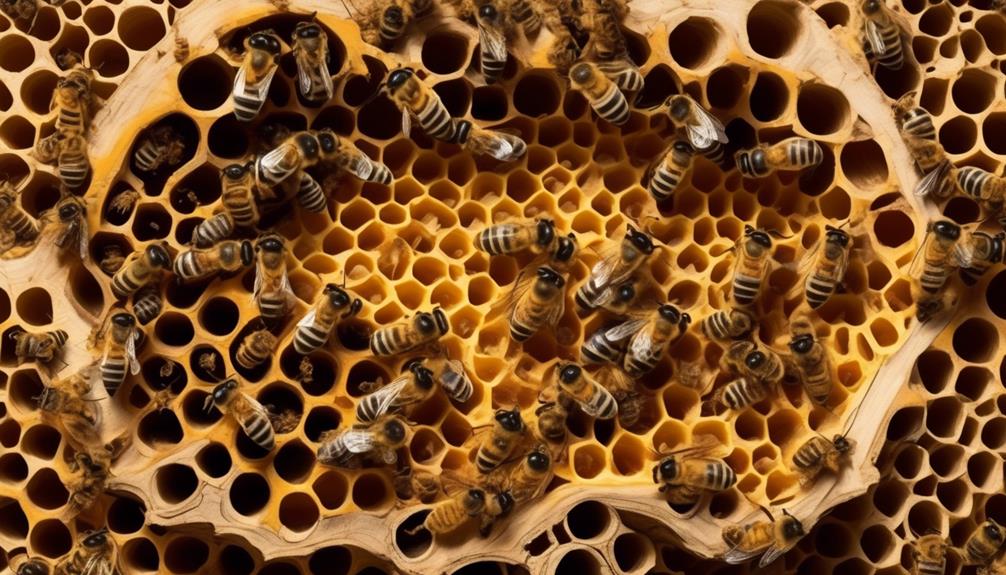
How to Tell if Bees Are Building a Hive?
Did you know that a single honeybee colony can construct a hive capable of housing up to 80,000 bees?
If you're noticing an increased number of bees buzzing around your garden, you might be wondering if they're just passing through or setting up a permanent residence.
Deciphering bee behavior and understanding the signs of hive construction isn't something you're born knowing, but it's certainly a skill you can acquire.
Stick around and we'll explore how to determine if those busy bees are indeed building a hive nearby.
Key Takeaways
- Swarms of bees clustering together indicate hive construction.
- Wax or propolis can be found in the suspected area.
- Honeycombs resembling structures may be present.
- Buzzing sound can be heard near the hive.
Understanding Bee Behavior
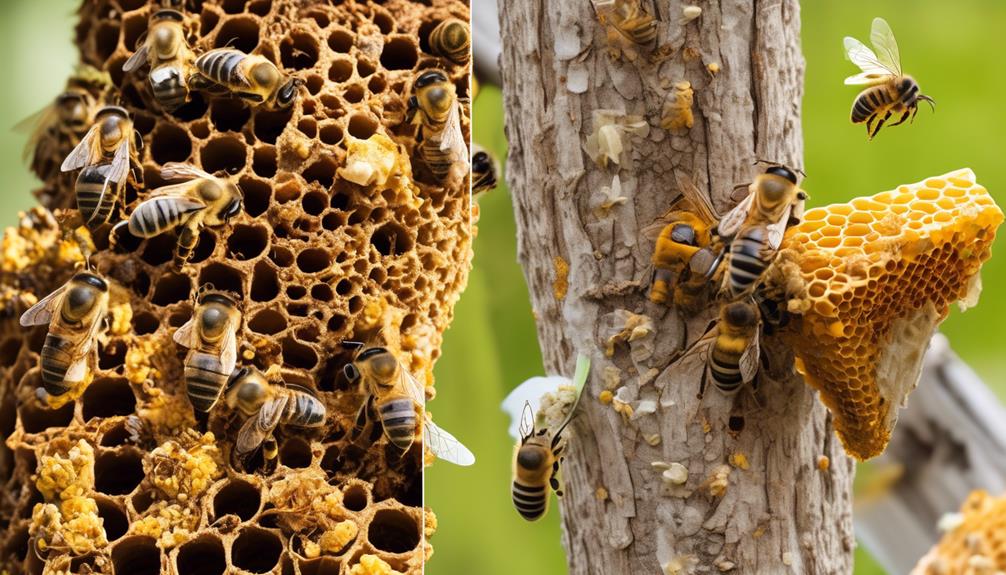
To fully grasp how to identify bee hives, you've got to first understand the unique behaviors of bees themselves. Bees are highly organized insects that work in a colony, with each bee having a specific role to play. Worker bees, for instance, are responsible for collecting nectar and pollen from flowers, which they transform into honey in the hive.
Notice how bees travel in a straight line when they return to their hive. It's like they've got an invisible GPS guiding them. If you spot bees flying in a particular direction, there's a good chance their hive is in that direction. Also, bees are more active during warm, sunny days and less so during rainy or cold days.
Be mindful of their defensive behavior. Bees sting when they feel threatened. If you wander too close to a hive, you'll likely see bees buzzing around you more aggressively. This is a clear sign that you're near their home.
Recognizing Hive Construction Signs
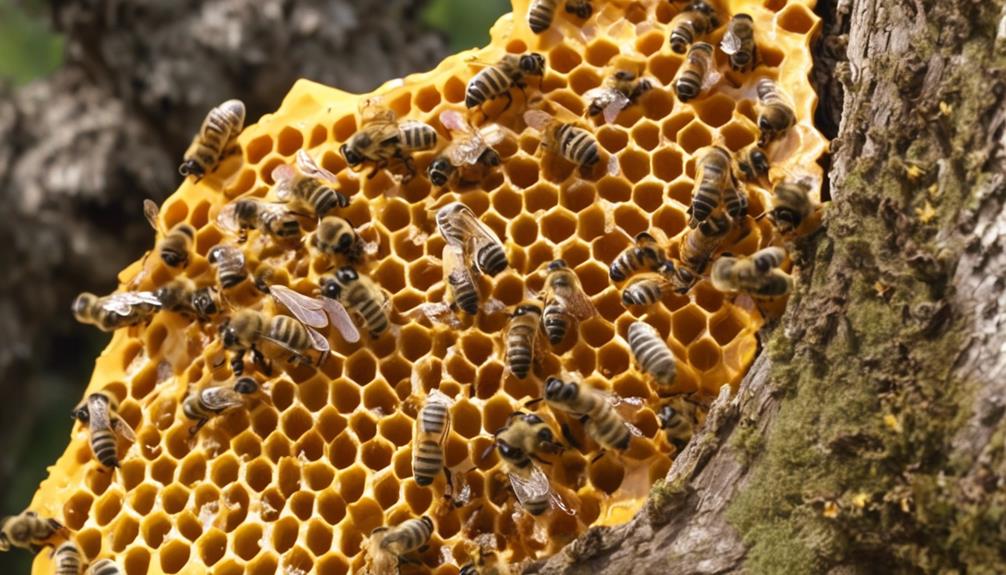
Having observed the behavior of bees, it's crucial you're also able to identify the physical signs of a hive's construction. Start by looking for the most obvious sign, the swarm. This is when a large group of bees clusters together, often seen hanging from tree branches or other structures.
Next, examine the suspected area for wax or propolis, a resinous substance bees use to seal gaps. Beeswax, usually a white or yellowish color, indicates a hive is being built.
Look for a structure resembling honeycombs, usually in enclosed spaces like hollow trees, attics, or wall cavities. Listen for a buzzing sound, a telltale sign of a hive's presence.
Observe the bees' flight pattern. They'll frequently fly in a path leading to and from their hive. This is called a bee line, and it's a clear sign of nearby hive construction.
Observing Frequent Bee Activity
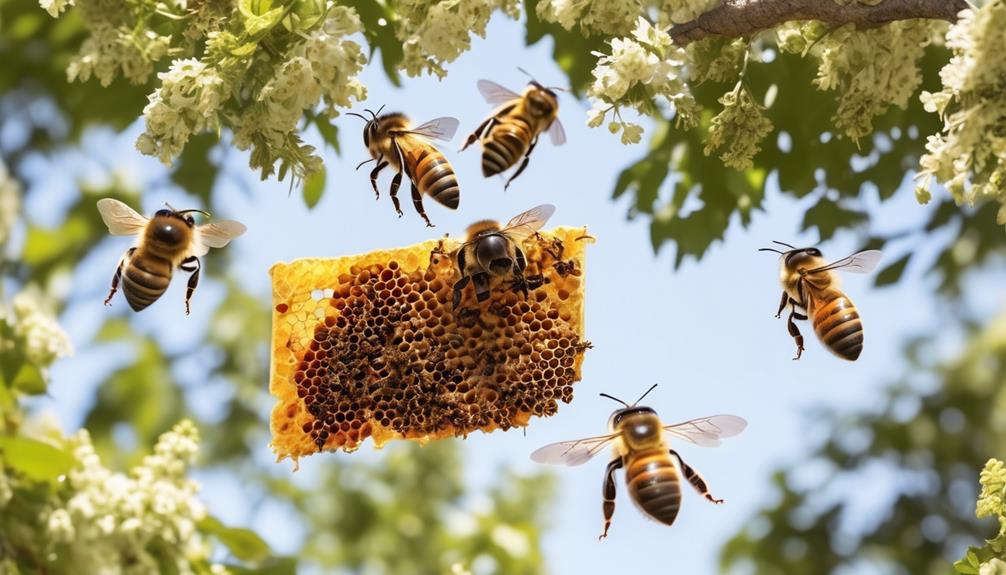
When you spot bees' frequent comings and goings, particularly in and out of a specific location, it's likely you've stumbled upon their bustling hive. This constant bee traffic is often the first and most obvious sign of a bee colony. However, it's not always as simple as it seems, and you'll need to observe carefully.
First, identify the flight path of the bees. They typically fly in a straight line to and from their hive, so this can help you pinpoint its exact location. Watch for bees carrying pollen, as these bees are definitely returning to a hive.
Second, take notice of the time of day. Bees are most active during daylight hours when the temperature is above 50 degrees Fahrenheit. If it's cooler or overcast, you mightn't see as much activity. Also, remember that different types of bees have different activity patterns.
Identifying Different Bee Species
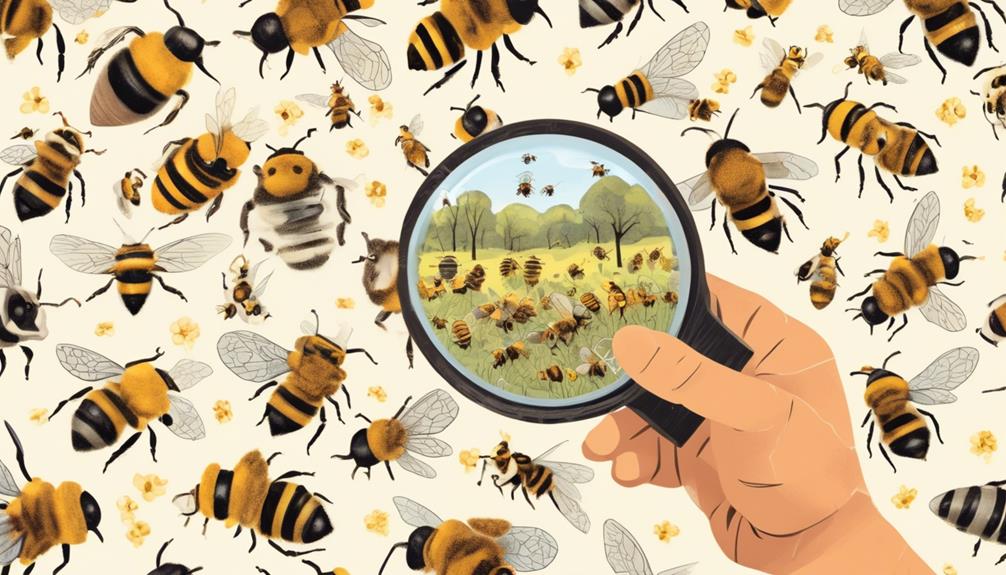
After pinpointing the location of a potential hive and observing their activity patterns, you'll want to focus on distinguishing between varying bee species. This knowledge can help you understand their habits and potential threats to your garden or home.
Firstly, look at their size and color. Honeybees are about half an inch long, with brown or golden-yellow bodies and black stripes. Bumblebees are larger, rounder, and furrier, with black and yellow patterns. Carpenter bees, another common type, are similar in size to bumblebees but have shiny, black abdomens.
Next, monitor their behavior. Honeybees are social, living in large colonies, and are often seen collecting pollen during daylight hours. Bumblebees also live in social colonies but are less numerous. Carpenter bees are solitary and known for burrowing into wood to lay their eggs.
Lastly, examine their hives. Honeybees make wax hives, often in hollow trees or walls. Bumblebees prefer dark, underground places like abandoned rodent burrows. Carpenter bees don't build hives but drill into wood to create nests.
When to Contact a Beekeeper
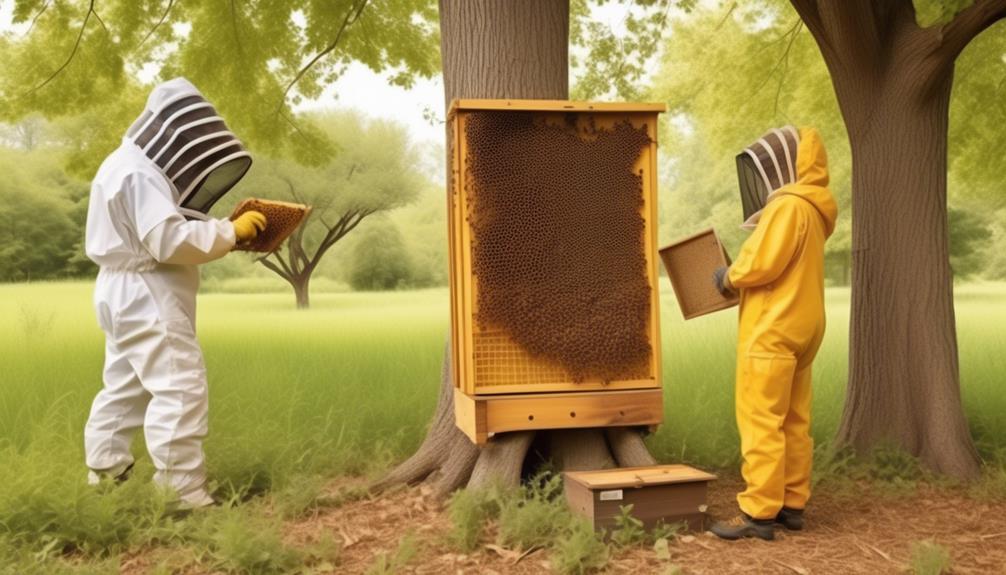
So, how do you know it's time to call in a professional beekeeper? Well, it's not just when you spot a few bees buzzing around your garden. Instead, look out for signs of significant bee activity. This can include seeing large numbers of bees entering and exiting a specific area, witnessing bees carrying pollen, or observing bees swarming.
If you've detected a hive, don't attempt to remove it yourself. Bees are crucial for the environment, but they can become aggressive if they feel their colony is under threat. At this point, it's safer and more practical to contact a beekeeper.
A professional beekeeper can safely remove the hive and relocate it without causing harm to the bees or your property. If you're unsure where to find a beekeeper, try local farming or gardening organizations. They often have contacts or could recommend someone.
Frequently Asked Questions
What Is the Life Cycle of a Bee?"
You're curious about the life cycle of a bee? It's fascinating!
Bees start as eggs laid by the queen. They hatch into larvae and are fed by worker bees. After about a week, they're sealed into their cells and pupate. When they emerge, they're adult bees.
Workers live for about six weeks in summer, while queens can live up to five years. It's a complex, well-orchestrated process that keeps the hive thriving.
How Far Can a Bee Travel From Its Hive?"
You're wondering how far a bee can travel from its hive.
The average bee can travel up to five miles for food, but distances may vary depending on the species and availability of resources. In desperate times, they've been known to fly up to ten miles. However, they prefer to stay within a two-mile radius to conserve energy.
What Are the Common Threats to a Bee Hive?"
Common threats to a bee hive include pests like mites, beetles, and wax moths.
You've also got to watch out for diseases such as American Foulbrood.
Weather conditions can be a threat, too, like extreme cold or heat.
Lastly, don't discount human activities. Pesticides, habitat loss, and even vandalism can put your bees at risk.
It's important to monitor these factors to maintain a healthy hive.
What Different Types of Hives Do Bees Build?"
You're likely to come across various types of bee hives.
Honeybees typically create intricate hives with hexagonal cells made of beeswax, known as honeycombs.
Bumblebees often nest in the ground or dense grass, creating simpler, smaller nests.
Carpenter bees burrow into wood to form their nests.
It's important to identify the type of hive to understand the bee species and behavior you're dealing with.
How Do Bees Communicate With Each Other Within the Hive?"
Bees communicate within the hive through a series of movements known as 'waggle dances.' You'd see a bee shaking its body in a figure-eight pattern. This dance communicates the direction and distance of a food source.
They also use pheromones for different purposes like signaling danger or guiding others.
It's fascinating, isn't it? They're not just buzzing around, they're having complex conversations that keep the hive functioning smoothly.
Conclusion
So, you've learned how to spot potential bee hives by understanding bee behavior, recognizing construction signs, observing bee activity, and identifying different species.
If you're noticing these signs, it's likely bees are setting up shop. Don't panic, but be mindful of their potential to become aggressive.
Reach out to a local beekeeper or pest control service for safe removal.
Remember, bees are crucial for our ecosystem, so let's treat them with respect and care.

